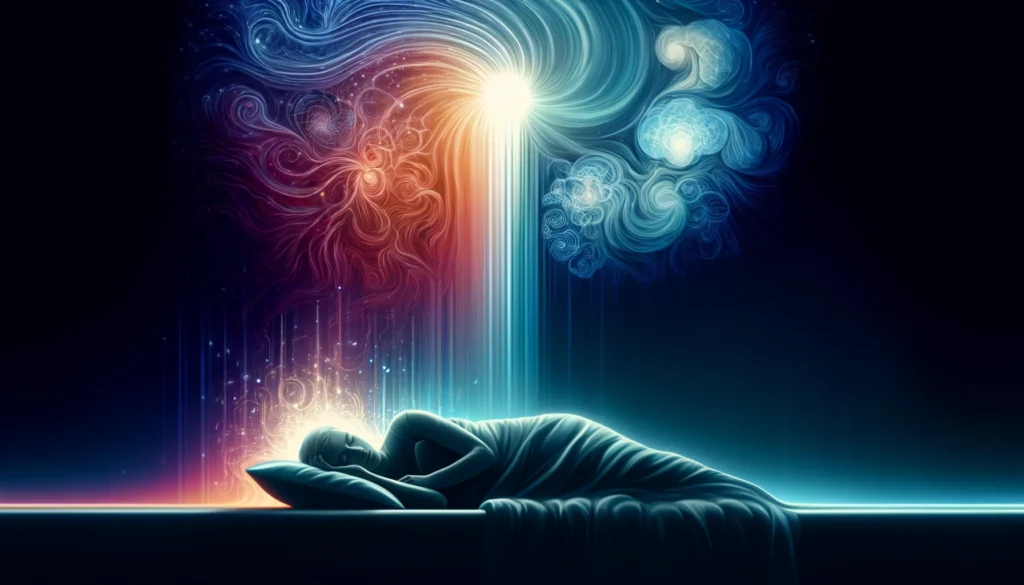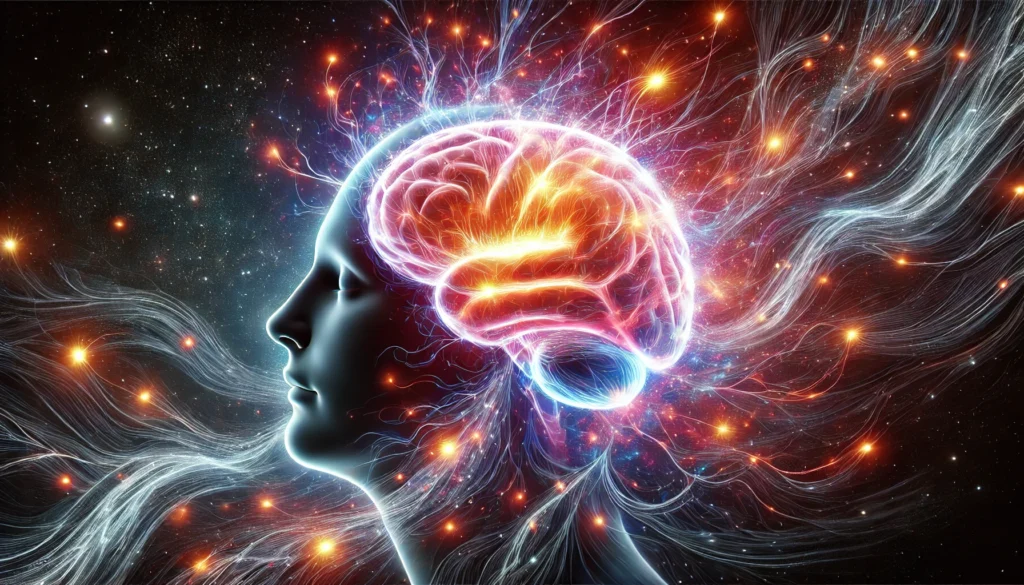To comprehend the relationship between dreams and REM sleep, it’s essential to first understand the sleep cycle. Our nightly rest is comprised of several stages, divided into non-REM (NREM) and REM sleep. NREM sleep is further categorized into three stages: N1 (light sleep), N2 (moderate sleep), and N3 (deep sleep or slow-wave sleep). REM sleep, the fourth stage, is characterized by rapid eye movements, increased brain activity, and vivid dreams.
You may also like: The Connection Between Sleep and Memory
The Architecture of Sleep
The sleep cycle is a structured interplay between different stages, each with distinct physiological functions. NREM and REM sleep alternate in cycles of about 90 minutes throughout the night. The transition from wakefulness to sleep begins with N1, progressing through deeper stages until REM, which punctuates the cycle with its unique characteristics. Understanding this architecture helps appreciate how each stage contributes to our physical and mental health.
The Role of NREM Sleep
NREM sleep is often overshadowed by the allure of REM, yet it plays an indispensable role in the sleep cycle. N1 and N2 stages facilitate the initial transition into sleep, while N3, or slow-wave sleep, is crucial for physical restoration and energy conservation. During NREM, the body repairs tissues, strengthens the immune system, and consolidates memories, setting the stage for REM’s intricate dreaming.
The Transition to REM Sleep
As the sleep cycle progresses, the body transitions from the restorative phases of NREM into the more dynamic REM sleep. This transition is marked by increased brain activity, similar to wakefulness, yet the body remains in a state of temporary paralysis to prevent acting out dreams. The seamless shift between these stages underscores the brain’s intricate orchestration of sleep and dreams.
NREM Sleep: More Than Just Rest
While REM sleep is often associated with dreaming, it is not the only time dreams occur. NREM sleep, particularly stages N1 and N2, can also produce dreams, although they are typically less vivid and more fragmented. The function of NREM sleep predominantly revolves around physical restoration, memory consolidation, and growth processes.
Dreams in Light Sleep
Dreams occurring in NREM stage N1 are often fleeting and disjointed, reflecting the brain’s gradual transition from wakefulness. These dreams can be influenced by external stimuli, such as sounds or light, which can be incorporated into the dream narrative. Although less structured than REM dreams, N1 dreams still provide insights into the mind’s ongoing processing during light sleep.
The Role of N2 in Dreaming
NREM stage N2 is where more substantial sleep begins, yet it still allows for dream experiences. Dreams in this stage can be tied to recent events or emotions, albeit in a less vivid manner than REM dreams. The brain continues to process information and emotions, suggesting that N2 serves as a bridge between the conscious and subconscious mind.
Deep Sleep and Dream Formation
NREM stage N3, or deep sleep, is primarily associated with physical restoration rather than dreaming. However, it is not devoid of dream activity. Dreams in N3 are often less frequent and lack the complexity of REM dreams but may still occur, offering a glimpse into the subconscious processing that occurs even during the deepest sleep phases.
REM Sleep: The Dream Factory
REM sleep is often dubbed the “dream factory” because it is the stage where the majority of vivid dreaming occurs. During REM, brain activity levels resemble those of wakefulness, leading to the generation of intricate and often bizarre narratives that we experience as dreams.
The Characteristics of REM Dreams
REM dreams are renowned for their vividness, emotional intensity, and narrative complexity. The heightened brain activity during REM, particularly in the limbic system, contributes to the emotional depth and imaginative scenarios that define these dreams. This stage is when the brain weaves together memories, emotions, and sensory experiences into elaborate dreamscapes.
The Role of the Limbic System
The limbic system, a group of brain structures associated with emotions, plays a pivotal role during REM sleep. This system’s activation explains why REM dreams are often emotionally charged and can include themes of fear, joy, or anxiety. Understanding the limbic system’s involvement helps decode the emotional narratives that populate our dreams.
The Impact of REM on Memory and Creativity
Beyond dreaming, REM sleep is crucial for memory consolidation and creativity. During this phase, the brain processes and organizes information, making connections between disparate ideas. This cognitive processing not only aids learning and memory retention but also fosters creative problem-solving, underscoring REM’s essential role in cognitive health.

Can You Dream Outside of REM Sleep?
Contrary to popular belief, dreams are not exclusive to REM sleep. While REM is the stage most associated with vivid and narrative-like dreams, studies have demonstrated that dreaming can occur during NREM sleep as well. These dreams tend to be more mundane and less emotionally charged compared to their REM counterparts.
The Nature of NREM Dreams
NREM dreams often lack the elaborate plots and vivid imagery of REM dreams. They are usually shorter and more fragmented, reflecting the different cognitive processes at play. Despite their simplicity, NREM dreams still offer valuable insights into subconscious thoughts and can be influenced by daily activities or unresolved emotions.
Brain Activity in NREM Dreaming
The neural activity during NREM dreaming differs from that of REM, involving different brain regions. While REM dreams engage areas linked to emotion and visual processing, NREM dreams are thought to be rooted in more logical and analytical brain regions. This distinction highlights the diverse nature of dreaming across the sleep stages.
The Evolutionary Perspective
From an evolutionary standpoint, the ability to dream outside of REM sleep may have offered adaptive advantages. NREM dreams, being less emotionally intense, might serve as a mechanism for problem-solving or rehearsing potential future scenarios. This perspective suggests that dreaming, irrespective of sleep stage, plays a vital role in cognitive and emotional functioning.
What Percentage of Dreams Occur During REM Sleep?
Research indicates that approximately 80% of dreams occur during REM sleep. This high percentage underscores REM sleep’s pivotal role in the dreaming process. However, the remaining 20% of dreams that take place during NREM sleep highlight the brain’s capacity for imagination and narrative construction throughout the entire sleep cycle.
The Dominance of REM in Dream Research
The predominance of REM dreams has made this stage a focal point of dream research. Scientists are intrigued by the rich narratives and emotional depth of REM dreams, driving studies into their origins and functions. This focus has broadened our understanding of how dreams impact memory consolidation, emotional regulation, and mental health.
The Significance of NREM Dreams
Despite their lesser frequency, NREM dreams play a significant role in the sleep-dream relationship. They challenge the traditional view of dreaming as an exclusively REM phenomenon, prompting researchers to explore the full spectrum of dream activity. This broader perspective acknowledges the complexity of dreaming and its implications for cognitive and emotional processing.
Implications for Sleep Disorders
Understanding the distribution of dreams across sleep stages has practical implications for addressing sleep disorders. Conditions that disrupt REM sleep, such as sleep apnea or insomnia, may impair the quality and quantity of dreams, affecting cognitive and emotional health. Recognizing the importance of both REM and NREM dreams can inform therapeutic approaches for improving sleep quality and overall well-being.
Can You Dream Without REM?
The possibility of dreaming without REM sleep is a topic of ongoing research. While REM sleep is the most conducive environment for dreaming due to its unique brain activity patterns, NREM dreams prove that REM is not a prerequisite for dreaming. The distinctions between REM and NREM dreams may be attributed to different cognitive processes and brain activation patterns during these stages.
The Complex Mechanisms of Dreaming
Dreaming without REM sleep underscores the complexity of the brain’s dream-generating mechanisms. Different neural pathways and cognitive processes are activated during NREM dreaming, suggesting a more nuanced understanding of how the brain constructs dreams. This complexity invites further investigation into the diverse functions and purposes of dreaming.
Cognitive Processes in NREM Dreams
NREM dreams might involve different cognitive processes compared to their REM counterparts. These dreams could be influenced more by logical reasoning and problem-solving than emotional processing. Understanding these processes provides insights into how dreams might contribute to cognitive functions such as memory, learning, and adaptation.
The Future of Dream Research
As research progresses, the exploration of dreaming beyond REM sleep opens new avenues for understanding consciousness and brain function. Emerging technologies, such as neuroimaging, offer unprecedented opportunities to observe brain activity during different sleep stages. Future studies aim to unravel the mysteries of dreaming, potentially leading to breakthroughs in mental health and cognitive science.

Historical and Future Perspectives on Dream Research
Historically, dreams have been interpreted through various lenses, from ancient prophetic visions to Freudian psychoanalysis. Modern science has shifted towards a neurological understanding of dreams, focusing on the role of different brain regions and neurotransmitters. Future research aims to unravel the complexities of dreaming further, potentially leading to new insights into mental health and cognitive function.
The Evolution of Dream Theories
Dream theories have evolved significantly over centuries, reflecting changing cultural and scientific paradigms. From ancient civilizations viewing dreams as divine messages to Freud’s interpretation of dreams as manifestations of repressed desires, each era offers unique perspectives. Understanding this evolution helps contextualize current research within a rich tapestry of historical thought.
Neurological Advances in Dream Study
Recent advances in neuroscience have revolutionized the study of dreams, shifting focus from speculative theories to empirical research. Scientists now investigate the specific brain regions and neurotransmitters involved in dreaming, offering a more grounded understanding of this complex phenomenon. This shift has opened new possibilities for exploring the neural underpinnings of dreams and their implications for mental health.
Future Directions in Dream Research
Looking forward, dream research is poised to explore the intersections of technology and neuroscience. Techniques such as real-time brain imaging and machine learning may uncover deeper insights into dream content and function. As our understanding of dreams expands, it holds potential for applications in therapy, creativity enhancement, and improving cognitive function.
Practical Implications for Health and Wellness
Understanding the connection between dreams and REM sleep has practical implications for health and wellness. Quality sleep, including sufficient REM cycles, is essential for cognitive health, emotional regulation, and overall well-being. Sleep disturbances that affect REM sleep, such as sleep apnea or insomnia, can disrupt the dream cycle, potentially impacting mental health.
Sleep Quality and Mental Health
Quality sleep, enriched with REM cycles, is crucial for mental and emotional health. REM sleep contributes to emotional regulation, helping process and integrate emotions from waking life. Disruptions in REM sleep can lead to increased stress, anxiety, and mood disorders, highlighting the importance of maintaining healthy sleep patterns for mental well-being.
Strategies for Enhancing REM Sleep
Various strategies can enhance REM sleep quality and, consequently, the richness of the dream experience. Techniques such as sleep tracking, cognitive behavioral therapy for insomnia (CBT-I), and mindfulness practices can improve sleep quality. These approaches not only promote restorative sleep but also support cognitive and emotional health through enriched dreaming.
The Role of Lifestyle in Dream Quality
Lifestyle factors, including diet, exercise, and stress management, significantly influence sleep quality and dream patterns. A balanced lifestyle supports the natural progression of sleep cycles, fostering optimal conditions for REM and NREM dreaming. Understanding the interplay between lifestyle choices and sleep can empower individuals to enhance their sleep quality and overall well-being.

Conclusion
The connection between dreams and REM sleep is a fascinating intersection of neuroscience and psychology. While REM sleep remains the primary stage for vivid dreaming, the occurrence of dreams during NREM sleep reminds us of the brain’s incredible capacity for imagination and narrative formation. As research progresses, our understanding of dreams and their implications for health and wellness will continue to evolve, offering new possibilities for enhancing our mental and emotional well-being.
By integrating historical insights, current research, and future trends, this article aims to provide a comprehensive overview that is both informative and thought-provoking, helping readers appreciate the intricate dance between dreams and REM sleep. The ongoing exploration of dreams not only enriches our understanding of the human mind but also holds promise for improving mental health, creativity, and cognitive function in the years to come.
Further Reading:
The Possible Functions of REM Sleep and Dreaming
REM Sleep Behavior Disorder (RBD)
Important Note: The information contained in this article is for general informational purposes only, and should not be construed as health or medical advice, nor is it intended to diagnose, prevent, treat, or cure any disease or health condition. Before embarking on any diet, fitness regimen, or program of nutritional supplementation, it is advisable to consult your healthcare professional in order to determine its safety and probable efficacy in terms of your individual state of health.
Regarding Nutritional Supplements Or Other Non-Prescription Health Products: If any nutritional supplements or other non-prescription health products are mentioned in the foregoing article, any claims or statements made about them have not been evaluated by the U.S. Food and Drug Administration, and such nutritional supplements or other health products are not intended to diagnose, treat, cure, or prevent any disease.


